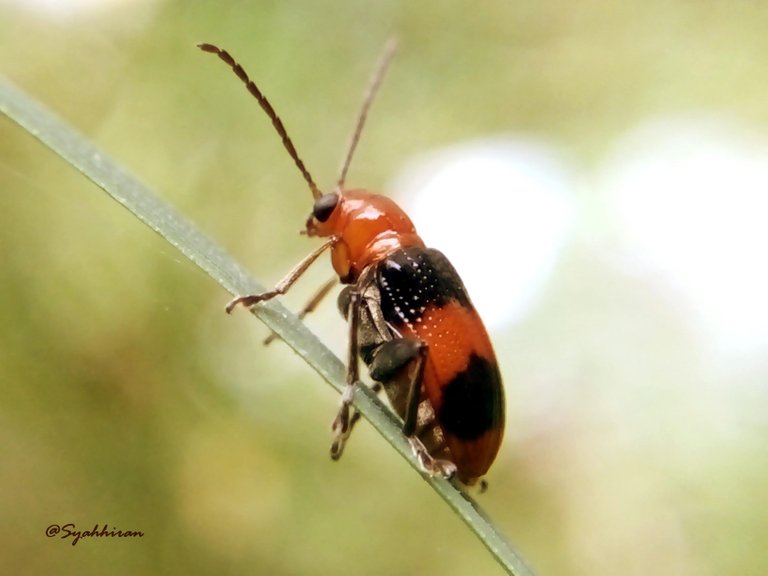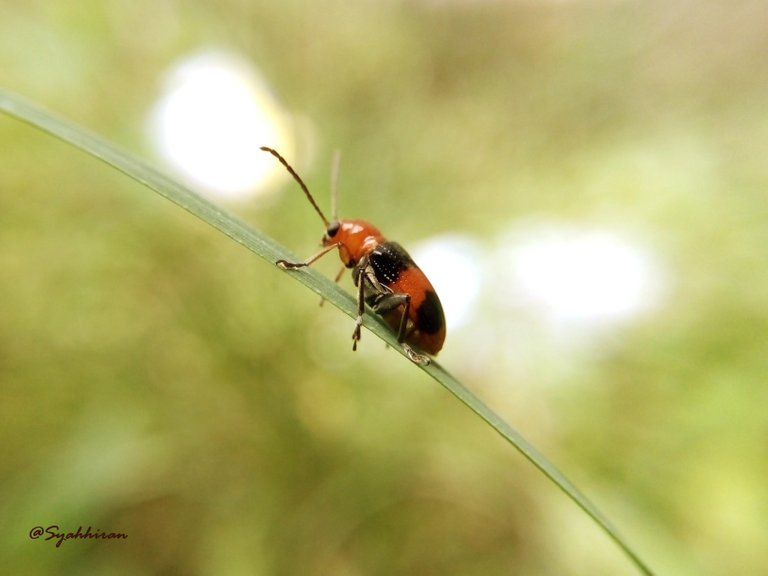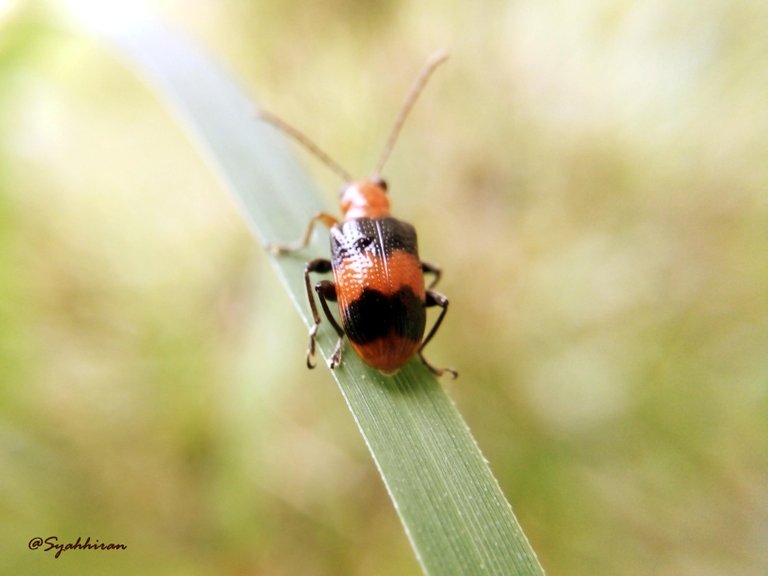This insect is often found in piles of rice that has been cut, I know this because I also once a farmer in the fields, we in aceh always piling our rice after cut, we call the newly cut rice pile as the title 'leumpoek', in this Leumpoek Very often this insect is found, its shape is small, with black body and orange, and have two beautiful antenna, really extraordinary creation of God the most loving, the most merciful.


Description of this Insect;
With the lack of a cold winter this year, the Dendrobium beetle (Stethopachys formosa) is already active. For those who aren’t familiar with Dendrobium beetles, they grow to about 12mm (½ inch) in length, similar to a ladybird in size. They are bright orange with four black spots on their wing covers and large black antenna. They are quite distinctive and very easily identified.
Dendrobium beetles are perhaps the orchids most destructive pests. They are natives of Australia and are found in the northern part of Northern Territory, throughout Queensland and northern New South Wales. They can also survive further south in the protection of shade houses. They mainly feed on species and hybrids of Dendrobium, but will feed on many other species of orchids. The adult beetle feeds on the leaves, flowers, buds and seed pods of the orchid. They are especially efficient at destroying all the forming flower buds if not controlled.
The adult beetle will lay its eggs on new growths, buds and flowers. The eggs are very tiny, about 1.5mm long, elongated and a greenish cream in colour.
After about 10 days, the beetle larvae will emerge and tunnel into the new shoots causing them to turn soggy and die. They will also feed on on the leaves causing significant damage.
These larvae will grow to 8 to 10mm (1/3 inch) in length during which time they will eat out the flesh in the orchid canes.
The larvae pupate in a mass of white, waxy material, similar to toothpaste before the adult emerges. This mass is usually at the base of the canes amongst the surface roots but can be in the base of leaves or even on the leaves themselves. The mass is usually 10 to 20mm (.5 to .75 inch) in size.
The life cycle of this beetle is only a couple of months, so it can be very destructive. The Dendrobium beetle is active during the warmer months, but you will find the occasional beetle in winter, especially in winters like this one where it has been unusually warm.
The best method to control this pest is to ensure your orchid house is sealed preventing this beetle from getting into your shade house. Depending on the design of your orchid house, this is not always possible and it definitely does not help those orchids growing outside. Although this beetle is quite easy to control with most insect sprays, eg. carbaryl, the larvae is very difficult to control as they are usually inside a cane and thus not reachable by non-systemic sprays. Most poisons that are not totally toxic to yourself, your orchids and the environment will not control this pest particularly well. Fortunately, this beetle is fairly easy to see and quite easy to catch and squash (if you are not too squeamish).
The Dendrobium beetle can fly, although adult beetles seldem seem to fly. If threatened, they merely curl up and drop to the ground where they are virtually impossible to locate unless you happen to have a concrete floor. Thus, to catch this beetle, the simplest method is to place a large mouth jar under the beetle and give the beetle a gentle tap. The beetle will curl up and drop off the leaf into the jar. Be warned however, that even though the adult beetles seldom seem to fly, the younger beetles with pale colouring seem much happier to fly and will regularly fly off on your approach. To ensure you catch the young pale beetles, you must be fast and tap them quickly before they get the urge to fly.
Once you have your beetle safely in the jar, you can then squash the beetle, or the squeamish can keep a small amount of water in the bottom of the jar. (As well as not seemingly being able to fly, these beetles don’t seem to be able to swim.) Again, the mature dark adult beetles will not attempt to fly from the bottle, but the younger pale beetles will often attempt to fly from the bottle if it does not contain water, so squash quickly if you are using the squash technique.
If you use the drowning method to kill these pests, it has been pointed out to me that the addition of a little cooking oil to the water in the jar (or using all cooking oil) will result in the beetles drowning almost immediately instead of drowning slowly. After trying this method, it is indeed a much quicker method, so I would recommend it over straight water.
In summary, always keep a glass jar in your orchid house. (Always keep a lid on the jar, as it prevents mosquitos breeding in the jar.) Always keep an eye out for these destructive pests and use the glass jar when you find them. It will save you a lot of chewed flowers and leaves.
Graham Corbin


Thank you for visiting my steemit page, the positive suggestions and criticisms I really hope for, in order to progress us together in this block chain social networking, thank you so much for my friends who have given upvote, and thank you as much as possible for friends who still pay attention to me , And I really hope to be able to repay the favor of all of you, who has been continuing to support and support me, if there is a mistake in writing please forgive, because I am new in English.
and see you on next post, and hopefully this simple insect article, can provide feedback for all friends, and if anyone wants to add please make comments in the column comment below.
Peace Love and Success always be with you.
Aceh, agust, 1 2017
@syahhiran.
Hi! I am a robot. I just upvoted you! I found similar content that readers might be interested in:
http://www.bos.org.au/Articles/Dendrobium%20Beetles.html
Sep gron poto droeneuh @syahhiran, pajan na wate untuek neu peurunoe long cahra seumoto njang beutoi, long golom got jeut long pakek macro, oeh watee long cok gamba seureng nget ngot.. Nyan payah neupuruno siat kiban cara beu lage droe neuh hasel jih, pu payah long blo kamera meuhai atoe jeut ngoen kamera biasa.
interesting postings to look at. how you can get clear images I like.